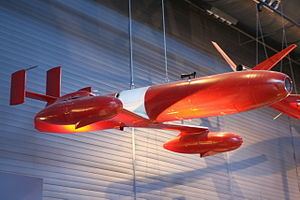Manufacturer Curtiss-Wright | ||
 | ||
The Curtiss-Wright KD2C Skeet was an American target drone produced by Curtiss-Wright that began development in 1945.
The Skeet was a pulsejet-powered, air-launched expendable drone designed for the U.S. Navy for fleet gunnery training. It could use a 36-centimeter (14-inch) McDonnell J-11, McDonnell J-9 or Continental pulsejet engine. Control was provided by two axis elevators and ailerons through a radio receiver and gyro stabilizing system. The drone could fly for 30 minutes and reach 540 kilometers (335 miles) per hour."
"The Skeet project began in August 1945 and produced its first experimental model was produced in 1947. However, the Skeet's unusual internally mounted pulsejet proved unsatisfactory because it produced low speed and high fuel consumption in both wind tunnel and flight tests at the Navy's Missile Test Center at Point Mugu, California. The project was cancelled in 1949."
Specifications (KD2C-2)
Data from Placard at Udvar-Hazy
General characteristics
Performance
